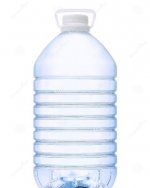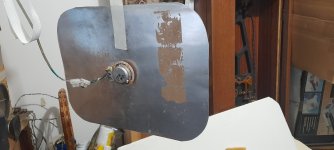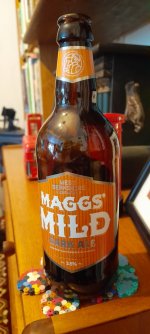What kind of sound it might give, if you put the exciter on the mouth of an empty Ajax Floral Fiesta bottle? The bottle mouth matches the exciter diameter. It is plastic and somewhat flatter. Plastic milk bottle mouth also matches the exciter diameter. There are lot of plastic bottles in any home that matches the exciter's diameter.Did a new test yesterday. I put my exciter (DEAX25HFE-4) on the top of my bourbon bottle and played one of my favorites (Dire Straights, Telegraph Road). Fortuitously, the top of the bottle had a nice flat surface of the perfect diameter for the exciter. When the bottle was (nearly) full, the sound wasn't great. Low efficiency and very biased to high frequency. Luckily, the exciter has a little hole, so I was able to pour out the bourbon little by little. By the time the bottle was empty, it sounded great!
I did some REW frequency measurements, but curiously, they were almost identical full and empty. Can't explain. Is anybody willing to verify these results with their own tests?
Eric
View attachment 1120946 View attachment 1120947
The new small aluminium panel is the first picture .
The second was taken in 2014 with some of the other panels I had.
The green one in the front with the grey circle is the aluminium panel with exciter still attached.
I found the third picture on my phone while looking for the aluminium panel photos.
It has nothing to do with DML , I just enjoyed drinking it. 🤣
Steve.
The second was taken in 2014 with some of the other panels I had.
The green one in the front with the grey circle is the aluminium panel with exciter still attached.
I found the third picture on my phone while looking for the aluminium panel photos.
It has nothing to do with DML , I just enjoyed drinking it. 🤣
Steve.
Attachments
Hello EricHere's a question I've been thinking about lately: If we could actually design a panel that truly reacted like the "pebble in the pond" analogy, would it still have the wide dispersion character of a typical modal bending wave speaker (i.e. dml)? Or does the wide dispersion of a flat panel speaker require a modal character? What other characteristics of the speaker would benefit from (or be harmed by) the the reduction of modal behavior? I'm pretty sure that reduction of modal behavior would improve the impulse response and reduce "ringing" (perhaps these are mostly the same thing). But what else would be the effects?
Eric
Here is the patent from M Azima that I have in mind and that really questions me : WO2002013575A1. Have a look page 3 and 4.
Extract :
...It is an objective of this invention to avoid altogether or at least reduce the modal behaviour of the panel, either throughout the operating range or at least in the lower frequency range of operation. Ideally, the panel should behave as if it were infinite in size - that is no energy is reflected from the boundaries, despite its finite physical size. The core idea of the present invention is that the imposition of an acoustic aperture onto a conceptually infinite panel results in a net acoustic power available in the far field of the panel at below the coincidence frequency, and also above it .
I agree it would improve the IR. What about the diffusive characteristic which comes from the change in the phase relation between the frequencies according to the direction (I pointed not a long time ago to a patent explaining that : the coherence of the IR coming from different directions) ?In contrast, the present invention stipulates substantially terminating the panel structure at the panel boundaries, ideally to absorb incident bending wave energy. This is tantamount to an infinite panel with a fini te acoustic aperture imposed on it. This is a significant departure from the prior art and in fact an antithesis to a modal object.
... but is improving the IR a goal? Some months ago, before building DML, my answer would have been yes. Now, I am not so sure. The understanding of the hearing mechanism is the key point.
Understanding the edge termination remains one of the next steps.
Christian
Well, if you still want to have a flat panel as the loudspeaker and have the the exciter stuck onto the plane of the panel, you'd have to cut a hole, where the exciter's bobbin is, and paste the bobbin top just below the front surface of the panel. That is, you won't get the tunnel effect, when the bobbin top is just below the front surface, better still be on the same plane as the front surface of the flat panel. The area corresponding the inner circle of the bobbin is of no use to the flat panel as a loudspeaker. In other words, the top of the exciter's bobbin and the front surface of the flat panel must be in the same plane, and there should be a hole where the bobbin's inner circle is. If you want you can cover it later for aesthetics.
Wave termination is a civil engineering problem for coastal defence. Bear with me, I have not been at the Bourbon. One method used is to arrange large and small boulders in front of a concrete berm so that the waves energy is absorbed before it can be reflected by the berm. It occurred to me that the same principle could be applied to panels but using holes to create the reflection.Hello Eric
Here is the patent from M Azima that I have in mind and that really questions me : WO2002013575A1. Have a look page 3 and 4.
Extract :
...
I agree it would improve the IR. What about the diffusive characteristic which comes from the change in the phase relation between the frequencies according to the direction (I pointed not a long time ago to a patent explaining that : the coherence of the IR coming from different directions) ?
... but is improving the IR a goal? Some months ago, before building DML, my answer would have been yes. Now, I am not so sure. The understanding of the hearing mechanism is the key point.
Understanding the edge termination remains one of the next steps.
Christian
Think of a border around the perimeter where a random pattern of holes of a random size are drilled. Waves entering the border are reflected within the border multiple times absorbing their energy. The size and position of the holes in the border are wavelength dependent and the degree of energy loss dependent on the depth of the border but it could be helpful. This might be combined with ABH profiles on one set of holes as a cutter can be profiled to create an ABH profile.
Burnt
Göbel tried that costal defense...Wave termination is a civil engineering problem for coastal defence. Bear with me, I have not been at the Bourbon. One method used is to arrange large and small boulders in front of a concrete berm so that the waves energy is absorbed before it can be reflected by the berm. It occurred to me that the same principle could be applied to panels but using holes to create the reflection.
Think of a border around the perimeter where a random pattern of holes of a random size are drilled. Waves entering the border are reflected within the border multiple times absorbing their energy. The size and position of the holes in the border are wavelength dependent and the degree of energy loss dependent on the depth of the border but it could be helpful. This might be combined with ABH profiles on one set of holes as a cutter can be profiled to create an ABH profile.
Burnt
in a square panel.
I think that method has insufficient depth to the border and was designed to absorb energy by the use of silicon in the slots. I have never been convinced Gobel met his design objective.
Burnt
Sure, Göbel is mostly selling speaker wires, and in the USA. 🙂I think that method has insufficient depth to the border and was designed to absorb energy by the use of silicon in the slots. I have never been convinced Gobel met his design objective.
Burnt
Would you try the 5l empty water bottle?
NoSure, Göbel is mostly selling speaker wires, and in the USA. 🙂
Would you try the 5l empty water bottle?
Ok, no problem, that way you'd never know what sound would be produced by an enclosed panel, excited by the edge of the exciter bobbin top, which is the most efficient way to transfer the whole of the efficiency of the exciter, that is, without the unwanted middle empty area. Sort of without the standing waves.
Ammos tried with one flat 4mm glass panel and with two exciters (stereo), Sony sells an onmi speaker with a glass cylinder with three exciters (had been doing that for last few years). We simply can do that with just one exciter per 5 litre empty plastic bottle up-firing, per one channel.
Last edited:
To be kept in mind... I can't find where and when I have already seen that.The holes around a plate, not the boulders we can see at the sea shore.Wave termination is a civil engineering problem for coastal defence. Bear with me, I have not been at the Bourbon. One method used is to arrange large and small boulders in front of a concrete berm so that the waves energy is absorbed before it can be reflected by the berm. It occurred to me that the same principle could be applied to panels but using holes to create the reflection.
Think of a border around the perimeter where a random pattern of holes of a random size are drilled. Waves entering the border are reflected within the border multiple times absorbing their energy. The size and position of the holes in the border are wavelength dependent and the degree of energy loss dependent on the depth of the border but it could be helpful. This might be combined with ABH profiles on one set of holes as a cutter can be profiled to create an ABH profile.
Burnt
It would be interesting to see estimates of an energy balance of a panel, or any loudspeaker really. What energy is input at each frequency, what part is radiated, what part conducted, what part converted to heat. I would guess that if any scheme to absorb energy is actually working well, the media would heat up noticeably, and it’s characteristics would change within a short time of listening. One early experiment I did with xps was to put perforations along the edges of the sheet (with a soldering iron ☺️) I ended up with several rows of slots in various directions. I remember being surprised how little difference it made. I think that to have an effect, the obstacles need to be of the size of the wavelength you want to impede, and you quickly use up a lot of space. Ideal shape I think would be some sort of repeating, self-similar (fractal) pattern of increasing size (bc high freqs are absorbed first in any case). Hole arrays could fit that description. You also need to fill the holes with an absorber. Silicone won’t work well, it’s too elastic. Butyl mastic goo would be better as Eric mentioned, but I suspect the percentage absorption would be rather disappointing with that too.To be kept in mind... I can't find where and when I have already seen that.The holes around a plate, not the boulders we can see at the sea shore.
Another possibility is to integrate an absorber with the baffle - ie the baffle plate surrounds the panel at the edges instead of terminating the panel at the start of the baffle.
Seems half of the problems of audio are about absorbing unwanted sound energy. I was reading last night about transmission line speakers and how the long tapered cavity is all about absorbing the back wave without causing resonances. I thought why not just make a pipe that passes though the roof of your house an points at the sky. Rain might be an issue though.
Last edited:
Try putting the exciter off-centre.I performed a test with a 10” frame drum. Sound output was good. Soundstage was lacking. Complex music did not perform well. Acoustic fared well. I wonder if a very large frame drum might do well?View attachment 1121234View attachment 1121235
Again on the subject of damping, I think that overall it's a losing strategy for DML technology. If you do ever manage to create perfect edge damping, you will have killed the source of sound below coincidence.
Rather that attempt to absorb a problematic resonance, better to create more resonances - as many as possible, as evenly distributed as possible. Any new resonance 'placed' near another in frequency will (a) distribute energy between the two resonance peaks, lowering each from what it would have been if alone and (b) raise the average SPL near that frequency.
I feel sure I have observed this with the spectrum of my ellipses panel. Minimising opportunities for early reflections back to the exciter, minimising parallel edges, creating a smooth distribution of path lengths, and maximising both surface area and perimeter length produced more resonances and smoother spectrum.
Ideally we would have techniques to damp, shift or eliminate or create particular peaks with specific interventions (weights, damping, holes, ). I have found it very difficult to adjust anything predictably, or get a good handle on what is happening exactly when I eg, add a weight somewhere. I still believe such techniques are possible though.
Rather that attempt to absorb a problematic resonance, better to create more resonances - as many as possible, as evenly distributed as possible. Any new resonance 'placed' near another in frequency will (a) distribute energy between the two resonance peaks, lowering each from what it would have been if alone and (b) raise the average SPL near that frequency.
I feel sure I have observed this with the spectrum of my ellipses panel. Minimising opportunities for early reflections back to the exciter, minimising parallel edges, creating a smooth distribution of path lengths, and maximising both surface area and perimeter length produced more resonances and smoother spectrum.
Ideally we would have techniques to damp, shift or eliminate or create particular peaks with specific interventions (weights, damping, holes, ). I have found it very difficult to adjust anything predictably, or get a good handle on what is happening exactly when I eg, add a weight somewhere. I still believe such techniques are possible though.
So has anyone had a chance to test some closed cell foam?
I'm convinced that's what I'm using and love it. (Tracy Chapman - Give Me One Reason is playing and It's crazy how good these sound.) I have a bunch left but am thinking of building a wooden form lined with Reynolds Wrap and buy a can of some closed cell foam and give it a go at making a panel just to check against what I'm using.
It may take some trial and error to get the escape holes around the perimeter right to avoid any air pockets but I'll document and if it turns out OK I'll upload some photos and hopefully someone who tests a lot will follow suit and try some as well.
Or keep an eye out for an old cheap or junky sun baked cooler like this material came from.
I'm convinced that's what I'm using and love it. (Tracy Chapman - Give Me One Reason is playing and It's crazy how good these sound.) I have a bunch left but am thinking of building a wooden form lined with Reynolds Wrap and buy a can of some closed cell foam and give it a go at making a panel just to check against what I'm using.
It may take some trial and error to get the escape holes around the perimeter right to avoid any air pockets but I'll document and if it turns out OK I'll upload some photos and hopefully someone who tests a lot will follow suit and try some as well.
Or keep an eye out for an old cheap or junky sun baked cooler like this material came from.
You mean polyurethane foam?So has anyone had a chance to test some closed cell foam?
I'm convinced that's what I'm using and love it. (Tracy Chapman - Give Me One Reason is playing and It's crazy how good these sound.) I have a bunch left but am thinking of building a wooden form lined with Reynolds Wrap and buy a can of some closed cell foam and give it a go at making a panel just to check against what I'm using.
It may take some trial and error to get the escape holes around the perimeter right to avoid any air pockets but I'll document and if it turns out OK I'll upload some photos and hopefully someone who tests a lot will follow suit and try some as well.
Or keep an eye out for an old cheap or junky sun baked cooler like this material came from.
Clarification re my comment this morning about damping. I didn't mean that any and all damping is a bad idea, because it's clearly not a bad idea - you absolutely need materials with inherent damping. Just the idea of extreme damping simulating an infinite panel.
- Home
- Loudspeakers
- Full Range
- A Study of DMLs as a Full Range Speaker



